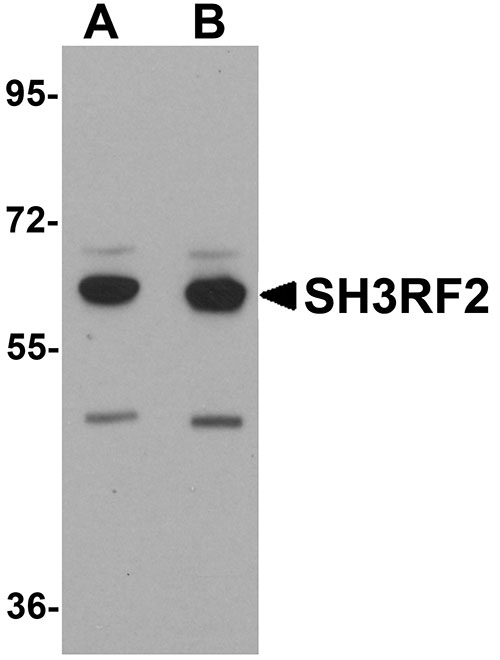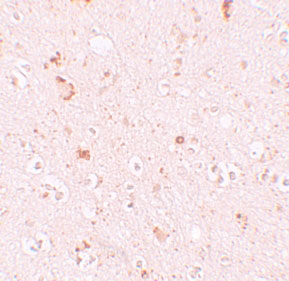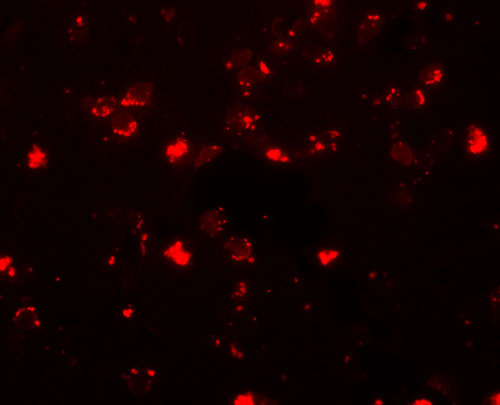SH3RF2 Antibody
- SPECIFICATION
- CITATIONS
- PROTOCOLS
- BACKGROUND

Application
| WB, IHC-P, IF, E |
|---|---|
| Primary Accession | Q8TEC5 |
| Other Accession | NP_689763, 222446607 |
| Reactivity | Human, Mouse, Rat |
| Host | Rabbit |
| Clonality | Polyclonal |
| Isotype | IgG |
| Calculated MW | 79320 Da |
| Application Notes | SH3RF2 antibody can be used for detection of SH3RF2 by Western blot at 1 - 2 µg/mL. Antibody can also be used for immunohistochemistry starting at 10 µg/mL. For immunofluorescence start at 20 µg/mL. |
| Gene ID | 153769 |
|---|---|
| Target/Specificity | SH3RF2; |
| Reconstitution & Storage | SH3RF2 antibody can be stored at 4℃ for three months and -20℃, stable for up to one year. As with all antibodies care should be taken to avoid repeated freeze thaw cycles. Antibodies should not be exposed to prolonged high temperatures. |
| Precautions | SH3RF2 Antibody is for research use only and not for use in diagnostic or therapeutic procedures. |
| Name | SH3RF2 |
|---|---|
| Function | Has E3 ubiquitin-protein ligase activity (PubMed:24130170). Acts as an anti-apoptotic regulator of the JNK pathway by ubiquitinating and promoting the degradation of SH3RF1, a scaffold protein that is required for pro-apoptotic JNK activation (PubMed:22128169). Facilitates TNF-alpha-mediated recruitment of adapter proteins TRADD and RIPK1 to TNFRSF1A and regulates PAK4 protein stability via inhibition of its ubiquitin-mediated proteasomal degradation (PubMed:24130170). Inhibits PPP1CA phosphatase activity (PubMed:19389623, PubMed:19945436). |
| Cellular Location | Nucleus. |
| Tissue Location | Heart (at protein level). Up-regulated in colon cancer tissues as compared to normal colon tissues (at protein level) Testis. In the heart, present in the apex, left atrium, right atrium, left ventricle and right ventricle, but not in the aorta |

Thousands of laboratories across the world have published research that depended on the performance of antibodies from Abcepta to advance their research. Check out links to articles that cite our products in major peer-reviewed journals, organized by research category.
info@abcepta.com, and receive a free "I Love Antibodies" mug.
Provided below are standard protocols that you may find useful for product applications.
Background
SH3RF2 Antibody: Although the SH3 domain containing ring finger 2 protein (SH3RF2) has been identified as a marker of the nucleus accumbens in the human brain, little is known about this protein. Recent yeast two-hybrid experiments have shown that SH3RF2 associates with protein phosphatase 1 (PP1) and is expressed primarily in heart and testis tissue. Recombinant SH3RF2 enhanced PP1 enzymatic activity and antagonized the ability of phopho-inhibitor-1 or -2 to inhibit PP1, suggesting that SH3RF2 may play a role working with PP1 in cardiac functions.
References
Ernst C, Sequeira A, Klempan, et al. Confirmation of region-specific patterns of gene expression in the human brain. Neurogenetics2007; 8:219-24.
Chen CY, Lai NS, Yang JJ, et al. FLJ23654 encodes a heart protein phosphatase 1-binding protein (Hepp1). Biochem. Biophys. Res. Commun.2010; 391:698-702.
If you have used an Abcepta product and would like to share how it has performed, please click on the "Submit Review" button and provide the requested information. Our staff will examine and post your review and contact you if needed.
If you have any additional inquiries please email technical services at tech@abcepta.com.













 Foundational characteristics of cancer include proliferation, angiogenesis, migration, evasion of apoptosis, and cellular immortality. Find key markers for these cellular processes and antibodies to detect them.
Foundational characteristics of cancer include proliferation, angiogenesis, migration, evasion of apoptosis, and cellular immortality. Find key markers for these cellular processes and antibodies to detect them. The SUMOplot™ Analysis Program predicts and scores sumoylation sites in your protein. SUMOylation is a post-translational modification involved in various cellular processes, such as nuclear-cytosolic transport, transcriptional regulation, apoptosis, protein stability, response to stress, and progression through the cell cycle.
The SUMOplot™ Analysis Program predicts and scores sumoylation sites in your protein. SUMOylation is a post-translational modification involved in various cellular processes, such as nuclear-cytosolic transport, transcriptional regulation, apoptosis, protein stability, response to stress, and progression through the cell cycle. The Autophagy Receptor Motif Plotter predicts and scores autophagy receptor binding sites in your protein. Identifying proteins connected to this pathway is critical to understanding the role of autophagy in physiological as well as pathological processes such as development, differentiation, neurodegenerative diseases, stress, infection, and cancer.
The Autophagy Receptor Motif Plotter predicts and scores autophagy receptor binding sites in your protein. Identifying proteins connected to this pathway is critical to understanding the role of autophagy in physiological as well as pathological processes such as development, differentiation, neurodegenerative diseases, stress, infection, and cancer.




